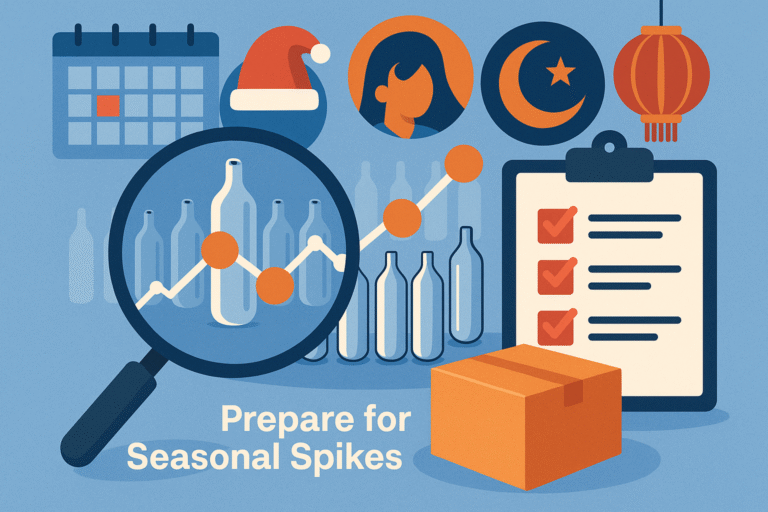(Q4, Ramadan, and Chinese New Year Risks Explained)
Every year, Q4 sales surge. Then comes Chinese New Year—and everything stops.
To stay ahead of seasonal demand spikes, N2O cream charger buyers must forecast by market, place orders early, lock factory capacity before Chinese New Year, and structure shipments to avoid congestion.

This guide helps you avoid stockouts, missed holidays, and shipment delays with real-time planning based on global demand calendars and China’s manufacturing cycle.
Global Cream Charger Demand Peaks by Region and Holiday
Cream charger consumption follows parties, not quarters. Different countries celebrate at different times.
Know the seasonal demand hotspots—and plan backwards from there.
| Region | Peak Season | Key Holidays | Ideal Order Date |
| Europe (FR, DE) | Oct–Dec | Halloween, Christmas, NYE | Sept 10 |
| USA | Aug–Jan | Back-to-school, Thanksgiving, NYE | Sept 15 |
| Australia | Nov–Jan | Summer Holidays, NYE | Aug 20 |
| SEA (Thailand, Vietnam) | Mar–Apr | Water Festival, Tourism Season | Jan 30 |
| Middle East | Varies | Ramadan, Eid al-Fitr | Feb 1–Mar 1 |
| China Supply Base | Jan–Feb (Supply Freeze) | Chinese New Year (CNY) | Dec 10 (lock) |
📌 CNY date shifts every year. In 2025, factories shut down from Jan 25 to Feb 15. Final shipments must leave ports by Jan 20 to avoid closure.
Why Shortages Still Happen—Even to Experienced Buyers
You placed your PO on time. Why did you still miss NYE or Ramadan?
Because everyone else ordered too late, and your production slot vanished.
Common Reasons for Q4/Q1 Failure:
- Design/artwork confirmed after Sept → missed production window
- No advance deposit → factory pushed you out for prepaid clients
- CNY peak → container shortage, port queues, frozen bookings
- Payment delay → missed vessel cutoff
- Overreliance on express shipping → costs exploded or didn’t arrive on time
📌 In high season, even 3 days late can cost you 2 weeks of delivery delay.
3 Simple Forecasting Models for Seasonal N2O Demand
Most buyers don’t use ERP. That’s okay. You just need clarity.
Use these 3 lightweight methods to project your peak needs:
| Model Name | How It Works | Use Case |
| YOY Growth Tracker | Q4 last year × projected channel growth % | Retail brands, e-commerce |
| Pre-Order Pipeline | Collect quantity intent from retailers/distributors | B2B wholesalers, stockists |
| Rolling Sales Ratio | Use average Aug–Oct run rate × seasonality index | Active volume sellers |
📌 Avoid over-forecasting. Round your purchase to the next full pallet or container only.
When to Place Orders for High-Volume Holiday Weeks?
Let’s break it down by timeline. Start from delivery deadline and subtract backwards.
| Step | Time Required |
| Design + Confirmation | 7–10 days |
| Production (OEM) | 20–25 days |
| Export Documents | 3–5 days |
| Sea Freight | 25–40 days |
| Customs + Last-Mile | 5–10 days |
Example:
Target: Deliver before Dec 20 (EU market) ✅ Order deadline: Sept 5 ✅ With OEM design: Aug 25
📌 Tip: Add 10 extra days if shipping during port congestion season (e.g., Shanghai before CNY).
Why Chinese New Year Can Disrupt Even Q1 Shipments
Most buyers underestimate how hard CNY hits the supply chain.
It’s not just a holiday—it’s a full industrial shutdown.
What Happens in CNY Season:
- Workers leave 7–10 days before the official break
- Production slows by mid-January
- Forwarders rush to book limited space
- Post-CNY, backlog delays last 2–3 weeks
- Factories prioritize returning clients with early deposits
📌 To secure post-CNY delivery in March–April, book your production no later than Dec 15.
Should You Lock Factory Capacity in Advance?
If you plan to move 1+ containers during Q4 or Ramadan, yes—lock it.
Here are 3 ways real buyers secure capacity:
| Strategy | Method | Benefit |
| Early Deposit | 30% upfront in August–September | Secures line & raw material |
| Frame Order Forecast | Signed volume target for Sept–Jan | Factory blocks time for you |
| Dual PO Planning | Q4 + post-CNY POs placed together | Gets post-holiday priority |
📌 Ask for a written slot confirmation—factories overbook if you don’t confirm early.
How to Ship Big Orders Without Overstock or Delay Risk
Full container orders come with risk. Use split strategies.
Pro buyers ship in waves, not once. Here’s how:
- Book 2 containers → split by flavor/region
- Use staggered B/Ls → clear customs gradually
- Combine LCL + FCL to keep channels running
- Keep 1–2 pallets in bonded warehouse for emergency
- For Europe: use EU-based 3PL to store Q1 inventory before CNY
📌 Want to maximize every container? Check our loading specs by tank size →
What If Prices Drop After You Bought Peak Inventory?
Yes, it happens. You buy in Q4, market softens in Q1. Now what?
Don’t panic. Here are recovery tactics buyers actually use:
| Strategy | Tactic |
| Promotional Exit | Bundle with dispensers, accessories in Q1 |
| Flash Sale Channeling | Push short-dated SKUs into low-price regions |
| Supplier Offset Credit | Negotiate lower rate for next restocking |
| Label Refresh | Repackaging to align with new product line |
📌 Add this clause to your PO: “If spot price falls >15% within 30 days of shipment, buyerreserves right to request partial credit.”
Conclusion
Peak season success comes from planning, not luck.
Mark your region’s demand spikes. Pre-book your factory. Don’t get caught by Chinese New Year. Ship smart. Think two containers ahead.




